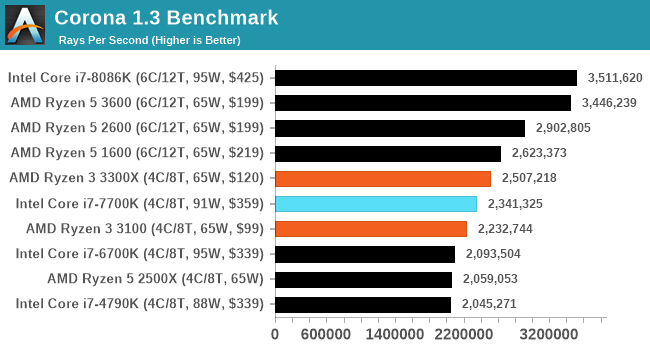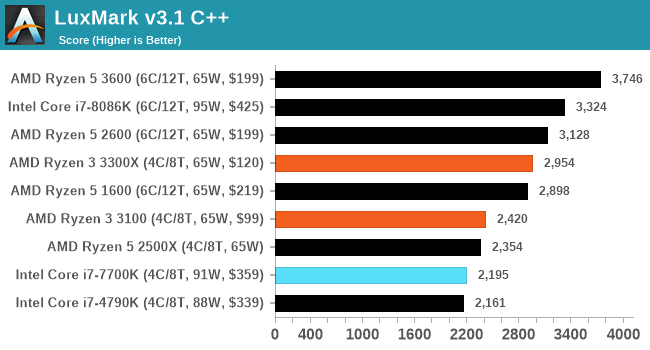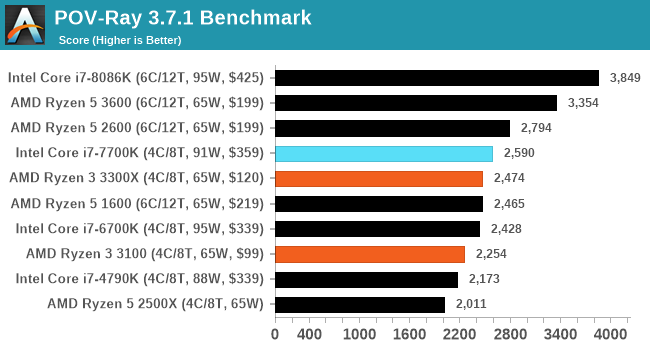The AMD Ryzen 3 3300X and 3100 CPU Review: A Budget Gaming Bonanza
by Dr. Ian Cutress on May 7, 2020 9:00 AM ESTCPU Performance: Rendering Tests
Rendering is often a key target for processor workloads, lending itself to a professional environment. It comes in different formats as well, from 3D rendering through rasterization, such as games, or by ray tracing, and invokes the ability of the software to manage meshes, textures, collisions, aliasing, physics (in animations), and discarding unnecessary work. Most renderers offer CPU code paths, while a few use GPUs and select environments use FPGAs or dedicated ASICs. For big studios however, CPUs are still the hardware of choice.
All of our benchmark results can also be found in our benchmark engine, Bench.
Corona 1.3: Performance Render
An advanced performance based renderer for software such as 3ds Max and Cinema 4D, the Corona benchmark renders a generated scene as a standard under its 1.3 software version. Normally the GUI implementation of the benchmark shows the scene being built, and allows the user to upload the result as a ‘time to complete’.
We got in contact with the developer who gave us a command line version of the benchmark that does a direct output of results. Rather than reporting time, we report the average number of rays per second across six runs, as the performance scaling of a result per unit time is typically visually easier to understand.
The Corona benchmark website can be found at https://corona-renderer.com/benchmark

LuxMark v3.1: LuxRender via Different Code Paths
As stated at the top, there are many different ways to process rendering data: CPU, GPU, Accelerator, and others. On top of that, there are many frameworks and APIs in which to program, depending on how the software will be used. LuxMark, a benchmark developed using the LuxRender engine, offers several different scenes and APIs.
In our test, we run the simple ‘Ball’ scene on both the C++ and OpenCL code paths, but in CPU mode. This scene starts with a rough render and slowly improves the quality over two minutes, giving a final result in what is essentially an average ‘kilorays per second’.

POV-Ray 3.7.1: Ray Tracing
The Persistence of Vision ray tracing engine is another well-known benchmarking tool, which was in a state of relative hibernation until AMD released its Zen processors, to which suddenly both Intel and AMD were submitting code to the main branch of the open source project. For our test, we use the built-in benchmark for all-cores, called from the command line.
POV-Ray can be downloaded from http://www.povray.org/












249 Comments
View All Comments
Spunjji - Tuesday, May 12, 2020 - link
Ah, we have an "enlightened centrist" here. No take is too worthless, malformed or ignorant for him. Anything less than subjecting yourself to the dribblings of fools and disinformation artists is an "echo chamber". Such rational, many smart.Ian Cutress - Friday, May 8, 2020 - link
You do realise that not all of the benchmarks have to confirm to your use case?There are two roads to take:
1) Out of ABCXYZ, Benchmarks XYZ are relevant to me. That's good.
2) Out of ABCXYZ, only Benchmarks XYZ are relevant to me. Why did you even bother testing ABC?
Not 100% of benchmarks have to be relevant to you. Plenty of other folks have requested these.
Spunjji - Monday, May 11, 2020 - link
Famrnuke - Thursday, May 7, 2020 - link
I'm sorry, WHAT? Userbench? I'll assume you're joking, because that's a god-awful "benchmark". PCMark is fine, but they gave many gaming results, so actually they've done better work than a lazy PCMark result.They did 7zip/WinRAR, imaging editing, video encoding, and browser tests as well.
Exactly what would using PCMark and Userbench add?
PeterCollier - Friday, May 8, 2020 - link
PCMark writing is a good test of system responsiveness.paulemannsen - Saturday, May 9, 2020 - link
Userbenchmark is so bad, it now gets ridiculed permanently and has become the Number 1 Meme in the community. PCMark measures, like you said yourself, SYSTEM-responsiveness, so its understandable if its not the top priority here. Furthermore, if you arent completely braindead you can extrapolate system-behaviour from a CPU-test/benchmark. Basically everything you spew here is demontrating your total ignorance and lack of knowledge of everything. You should be utterly ashamed of yourself.PeterCollier - Saturday, May 9, 2020 - link
Mind mentioning some facts when disparaging Userbenchmark?Spunjji - Monday, May 11, 2020 - link
Facts! Okay:It has a known Intel bias, it doesn't actually do anything that isn't covered by the tests shown here, and even if it did *some of us would still be happier with these real-world application benchmarks*.
PeterCollier - Monday, May 11, 2020 - link
Got some links?Spunjji - Tuesday, May 12, 2020 - link
Sure, here's one that's relevant to you:http://wondermark.com/1k62/